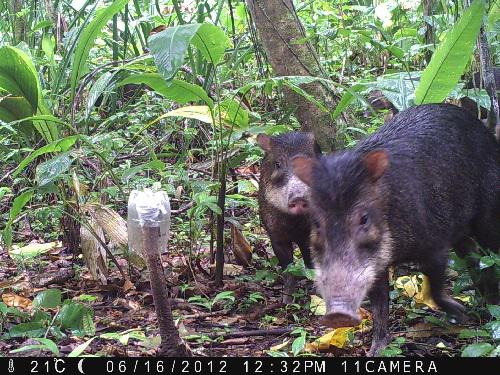Article featuring the project.
The World Into the Costa Rican wild: Jaguars feast on sea turtles
La Nacion Machos de jaguar se toleran y comen de la misma tortuga
9 May 2012 Tortuguero National Park, Costa Rica, Central and Latin America Carnivores | Mammals
Monitoring Jaguar Predator-Prey Interactions and Implementation of Mitigation Methods to Reduce Human-Wildlife Conflict in Tortuguero National Park, Costa Rica
This study aims to assess habitat selection by jaguar in order to determine jaguar habitat requirements and the effect of human perturbations on habitat use.

White-lipped Peccary, June 2012. © Stephanny Arroyo-Arce.
Tortuguero National Park is part of the Jaguar Conservation Units and should therefore be a priority area for directing the efforts of conservation of the species. However, the expansion of the agricultural frontier and the increased land use (agriculture/livestock) has led to the fragmentation of the park. The environmental consequences of such activities (e.g. loss of forest cover, change in land use, isolation of forest patches) will have negative impacts on the jaguar populations (e.g. low prey availability due to hunting, jaguar-human conflicts associated with the cattle predation on farms located in the buffer area of the park).
This study aims to assess habitat selection by jaguar in order to determine jaguar habitat requirements (e.g. forest cover type, prey availability) and the effect of human perturbations (e.g. agricultural areas, human settlements) on habitat use. Remote cameras with infrared sensor, transect-sampling and interview data will be used to detected jaguars, and occupancy models based on detection/non-detection records will be used to analyze the data. The selection of the habitat will be modelled according to the landscape variables, which will be selected based on the literature review and the characteristics of the study area.
The information obtained from occupancy models will be use to create a map showing the suitability of habitat for the jaguar in the Tortuguero National Park and its buffer area. Such information may be used as a framework to establish priority areas for conservation within the park and its buffer area, for example, areas with high rates of hunting and deforestation are particularly at risk. Assessing the use of such areas by jaguar populations will help in determining future conservation policies for those sites. It is expected that wildlife managers of the park will use the information generated as a complementary tool to make practical management and conservation actions of the jaguar in the Tortuguero National Park and its buffer zone.
Article featuring the project.
The World Into the Costa Rican wild: Jaguars feast on sea turtles
La Nacion Machos de jaguar se toleran y comen de la misma tortuga